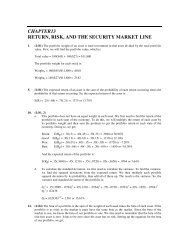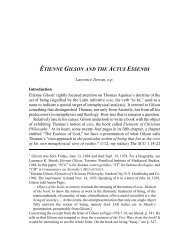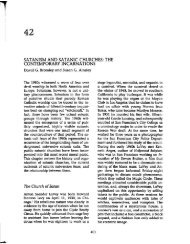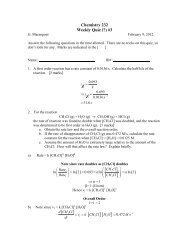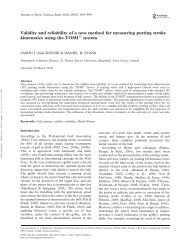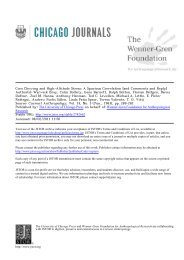Health and the Social Construction of Masculinity in Men's Health ...
Health and the Social Construction of Masculinity in Men's Health ...
Health and the Social Construction of Masculinity in Men's Health ...
You also want an ePaper? Increase the reach of your titles
YUMPU automatically turns print PDFs into web optimized ePapers that Google loves.
36 MEN AND MASCULINITIES / July 2004<br />
van Dijk 1993, 1997). CDA provides “an account <strong>of</strong> <strong>the</strong> role <strong>of</strong> language, language<br />
use, discourse or communicative events <strong>in</strong> <strong>the</strong> (re)production <strong>of</strong> dom<strong>in</strong>ance”<br />
(van Dijk 1993, 282). It <strong>in</strong>volves <strong>the</strong> analysis <strong>of</strong> l<strong>in</strong>guistic features<br />
such as vocabulary, grammar, textual structures, <strong>and</strong> punctuation to reveal<br />
hidden ideological assumptions on which discourse is based (Fairclough’s<br />
1992, 1989).<br />
The analysis focuses on <strong>the</strong> <strong>in</strong>teraction <strong>of</strong> three aspects: (1) <strong>the</strong> discursive<br />
construction <strong>of</strong> mascul<strong>in</strong>ity <strong>in</strong> <strong>the</strong> magaz<strong>in</strong>e through <strong>the</strong> creation <strong>of</strong> images<br />
<strong>of</strong> <strong>the</strong> ideal man, (2) <strong>the</strong> magaz<strong>in</strong>e’s role <strong>in</strong> reproduc<strong>in</strong>g male power, <strong>and</strong> (3)<br />
men’s health behavior, particularly <strong>the</strong> negative health behaviors associated<br />
with hegemonic mascul<strong>in</strong>ity listed by Courtenay (2000a).<br />
ANALYSIS AND DISCUSSION<br />
Although <strong>the</strong>re are many different writers <strong>in</strong> Men’s <strong>Health</strong>, <strong>the</strong>re are two<br />
ma<strong>in</strong> discourses that <strong>in</strong>tertw<strong>in</strong>e throughout <strong>the</strong> magaz<strong>in</strong>e, <strong>the</strong> discourse <strong>of</strong><br />
medical science <strong>and</strong> <strong>the</strong> discourse <strong>of</strong> <strong>the</strong> “buddy.” This buddy is a deliberate<br />
creation <strong>of</strong> <strong>the</strong> magaz<strong>in</strong>e: “We are like a buddy . . . not some pompous knowit-all”<br />
(Men’s <strong>Health</strong> editor, Stump 1999). The buddy acts as an <strong>in</strong>termediary,<br />
expla<strong>in</strong><strong>in</strong>g <strong>and</strong> <strong>in</strong>terpret<strong>in</strong>g medical science for <strong>the</strong> reader. The follow<strong>in</strong>g<br />
extract reveals <strong>the</strong> mesh<strong>in</strong>g toge<strong>the</strong>r <strong>of</strong> <strong>the</strong> two discourses:<br />
A . . . prelim<strong>in</strong>ary study from <strong>the</strong> Rowett Research Institute . . . found that a<br />
compound P3 <strong>in</strong> <strong>the</strong> yellow goop around tomato seeds reduced platelet clump<strong>in</strong>g<br />
by 72 percent. Lower platelet aggregation reduces <strong>the</strong> risk <strong>of</strong> blood clots...<br />
[next section] ...ifyour blood tests show elevated levels <strong>of</strong> homocyste<strong>in</strong>e, substitute<br />
a cold frosty one for <strong>the</strong> Merlot. Scientists ...gaveagroup <strong>of</strong> men w<strong>in</strong>e,<br />
beer, g<strong>in</strong>, or water with d<strong>in</strong>ner....Thew<strong>in</strong>e <strong>and</strong> g<strong>in</strong> raised homocyste<strong>in</strong>e levels<br />
a bit; <strong>the</strong> beer didn’t. (November 2000, 26)<br />
In this extract, terms such as “platelet aggregation” <strong>and</strong> “homocyste<strong>in</strong>e levels”<br />
from authoritative medical discourse are used, but <strong>the</strong>y are associated<br />
with scientists or researchers. At <strong>the</strong> same time, this discourse is mixed with<br />
<strong>in</strong>formal terms such as “yellow goop” <strong>and</strong> “a cold frosty one,” rem<strong>in</strong>d<strong>in</strong>g <strong>the</strong><br />
reader that it is <strong>the</strong> buddy speak<strong>in</strong>g, not <strong>the</strong> scientists. The buddy also <strong>in</strong>terprets<br />
<strong>the</strong> science <strong>and</strong> draws conclusions <strong>in</strong> <strong>the</strong> familiar voice <strong>of</strong> <strong>the</strong> lifeworld;<br />
<strong>the</strong> contents page reduces <strong>the</strong> above extract to “Why you need more<br />
pizza <strong>and</strong> beer” (November 2000).<br />
Given men’s lack <strong>of</strong> health care utilization (Courtenay 2000b, 83) <strong>and</strong><br />
unwill<strong>in</strong>gness to see a doctor (“I don’t go to <strong>the</strong> doctor unless someth<strong>in</strong>g<br />
scares <strong>the</strong> hell out <strong>of</strong> me.” Men’s <strong>Health</strong> editorial, June 2000, 16), <strong>the</strong> voice <strong>of</strong><br />
<strong>the</strong> buddy plays an important role <strong>in</strong> terms <strong>of</strong> power relations. If men take <strong>the</strong><br />
advice <strong>of</strong> a friend, <strong>the</strong>y are not capitulat<strong>in</strong>g to a more powerful expert, <strong>the</strong><br />
“pompous know-it-all.” At <strong>the</strong> same time, <strong>the</strong> buddy claims <strong>the</strong> back<strong>in</strong>g <strong>and</strong>



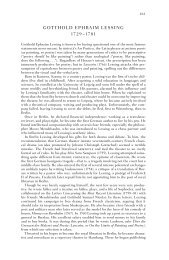

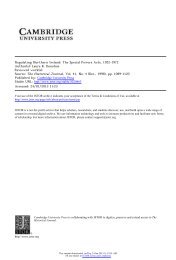

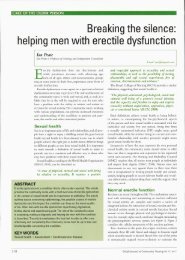
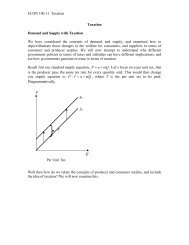
![The Rink - Cyril Dabydeen[1].pdf](https://img.yumpu.com/21946808/1/155x260/the-rink-cyril-dabydeen1pdf.jpg?quality=85)

